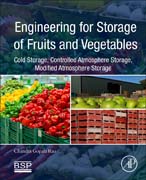
Engineering for Storage of Fruits and Vegetables is a comprehensive reference that provides an understanding of the basic principles of cold storage load estimation, refrigeration capacity calculations for various types of cold storages, and other topics of evaporative cooling, thus demonstrating the important principles for designing low cost precooling chambers. The book is written in an accessible manner to provide a solid understanding of different environments and their considerations to give readers the confidence they need to design suitable packaging materials by understanding parameters, including reaction rates, deteriorative reactions, Arrhenius equations, Q10, K, D, Z parameters, and their influence on reaction rates. Covers a wide variety of related topics, from post-harvest physiology of fruits and vegetables, to the various aspects of controlled atmosphere storagesExplains the application of water activities and enzyme kinetics for predicting shelf life of foods and design of packaging materialsIncludes solved problems and exercises which guide students and assist with comprehension INDICE: Part I: Pre Cooling of Fruits and Vegetables and their Storage Requirement 1. Introduction 2. Postharvest Physiology of Fruits and Vegetables 3. Estimation of Cooling Times of Foods 4. Pre-cooling of Fruits and Vegetables by Ventilation Method 5. Forced-Air Cooling of Fruits and Vegetables 6. Hydro Cooling of Fruits, Vegetables and Cut Flowers 7. Evaporative Cooling Systems for Fruits and Vegetables 8. Vacuum Cooling of Fruits and Vegetables 9. Handling and Storage of Common Fruits 10. Handling and Cold Storage of Vegetables Part II: Cold Storage 11. Handling and Cold Storage of Vegetables 12. Preliminaries for the Estimation of Cooling Loads 13. Air Conditioning Systems and Estimation of Cooling Load 14. Evaporators 15. Refrigerant Compressors 16. Condensers 17. Expansion Devices 18. Spray Ponds and Cooling Towers 19. Fans 20. Transmission and Distribution Systems of Cool Air 21. Heat and Water Vapour Transport in the Cold Storage 22. Thermal and Vapour Insulation Materials 23. Design of Small Capacity Cold Storages 24. Dimensions-Layout-Stacking Methods for Cold Storage 25. Transportation of Fruits - Vegetables and Flowers 26. Instrumentation and Climate Management in Cold Storage Part III: Controlled Atmosphere for Storage (CAS) Horticulture Produce 27. Operation, Maintenance and Energy Conservation in Cold Storage 28. Introductory Information of Controlled Atmosphere Storages 29. Biochemical Considerations of Controlled Atmosphere Storage 30. Gas Exchange Mechanisms in Controlled Atmosphere Storage 31. Mass Balance Principles Applied to CA Chamber 32. Gas Generators for Controlled Atmosphere Storage 33. Equipment for Producing and Regulating Controlled Atmosphere 34. Design, Construction and Operation of Controlled Atmosphere Storage Chambers Part IV: Modified Atmosphere Storage 35. An Overview of Modified Atmosphere Storage 36. MAP Technology 37. Gases and Vapour Applied to MA Processing Operations 38. Shelf Life of Foods 39. Kinetics of Food Deteriorative Reactions 40. Water Activity and Shelf Life 41. Effect of Logistics Environment on Shelf Life 42. Shelf Life Testing 43. MAP Modeling 44. Principles of Enzyme Kinetics 45. Enzyme Kinetics Applied to MAP 46. MAP Design with O2 Modelling (Experiments on Tomato Fruit) 47. Methods of Storing Fruits in Polymeric Packets with MAP
- ISBN: 978-0-12-803365-4
- Editorial: Academic Press
- Encuadernacion: Rústica
- Páginas: 924
- Fecha Publicación: 06/09/2015
- Nº Volúmenes: 1
- Idioma: Inglés
